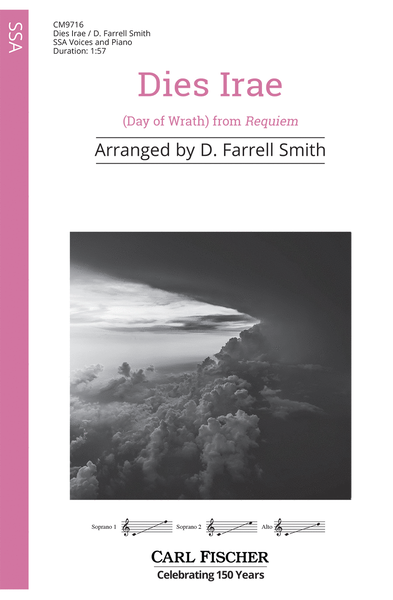Dies Irae
Day of Wrath
-
Ships in 1 to 2 weeks
Details
Description
SKU: CF.CM9716
Day of Wrath. Composed by David (D) Smith. 12 pages. Duration 0:01:57. Carl Fischer Music #CM9716. Published by Carl Fischer Music (CF.CM9716).ISBN 9781491160954. UPC: 680160919550. Key: D minor. Latin. Early Latin Text.
This text is taken from the Dies Irae Sequence from the Requiem Mass. It is a contemplation of the arrival of judgment day. The A-sections, mm. 1-29 & mm. 43-end, are a manic depiction of the fierce wrath of judgment day. They should be sung with fire, crisp consonants while always enunciating the accents in order to realize the full effect of this powerful text. The entire demeanor of the tone and facial expressions should change for the B-section, mm. 30-42 as it is a plea for mercy. The audience should realize the change in this contrasting section. Translation Dies irae, dies illa: Day of wrath, that day Solvet saeclum in favilla: shall dissolve the world into embers Teste David cum Sibylla: As David prophesied with the Sibyl. Voca me cum benedictis :Call me to be with the blessed. Salva me fons pietatis : Save me, fount of pity. The "Sibyl" is a reference from a Greek word, which means Prophetess. In this context, the word appears in plural, referring to many prophetesses. David, or King David, has long been considered prophetic among biblical scholars. About the Arranger D. Farrell Smith is the Director of Choirs at Hilldale Middle School, and Hilldale High School in Muskogee, Oklahoma. He holds a B.A. in Music Education and the M.A. in Theological Studies. Currently the Minister of Music at Eastern Heights Baptist Church, he has been a Music educator and Minister for 20 years. Mr. Smith studied with Dr. Gary Foster and Dr. Donald Studebaker and has performed under such notables as R. Evan Copley, Daniel Pinkham, Lloyd Pfautsch, and Bev Henson.
This text is taken from the Dies Irae Sequence from the Requiem Mass. It is a contemplation of the arrival of judgment day. The A-sections, mm. 1-29 & mm. 43-end, are a manic depiction of the fierce wrath of judgment day. They should be sung with fire, crisp consonants while always enunciating the accents in order to realize the full effect of this powerful text. The entire demeanor of the tone and facial expressions should change for the B-section, mm. 30-42 as it is a plea for mercy. The audience should realize the change in this contrasting section.TranslationDies irae, dies illa: Day of wrath, that daySolvet saeclum in favilla: shall dissolve the world into embersTeste David cum Sibylla: As David prophesied with the Sibyl.Voca me cum benedictis :Call me to be with the blessed.Salva me fons pietatis : Save me, fount of pity.The “Sibyl” is a reference from a Greek word, which means Prophetess. In this context, the word appears in plural, referring to many prophetesses. David, or King David, has long been considered prophetic among biblical scholars.About the ArrangerD. Farrell Smith is the Director of Choirs at Hilldale Middle School, and Hilldale High School in Muskogee, Oklahoma. He holds a B.A. in Music Education and the M.A. in Theological Studies. Currently the Minister of Music at Eastern Heights Baptist Church, he has been a Music educator and Minister for 20 years. Mr. Smith studied with Dr. Gary Foster and Dr. Donald Studebaker and has performed under such notables as R. Evan Copley, Daniel Pinkham, Lloyd Pfautsch, and Bev Henson.

 Share
Share